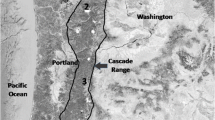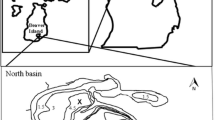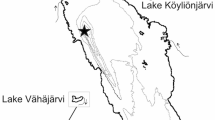Abstract
Lake Vanda is a permanently ice covered, meromictic, closed basin lake, located in the Dry Valley region of Southern Victoria Land, Antarctica. A unique feature of the lake water column structure is that the bottom lake waters exist as a natural diffusion cell. The diffusive nature of these waters allows rates of sulfate reduction, nitrification and denitrification to be calculated from nutrient concentration gradients. Calculation reveals that sulfate reduction is by far the most important anoxic process acting to oxidize organic material. In addition, rate calculations reveal that bottom water nutrient profiles are in steady state. One argument in support of this conclusion is that the calculated rate of nitrification balances the flux of ammonia from the anoxic lake waters. The flux of phosphorus from the reducing waters is several times less than would be predicted from the nitrogen and phosphorus content of decomposing lake seston. Solubility calculations show that phosphorus may be actively removed at depth in Lake Vanda by the formation of hydroxyapatite. It is found that estimated rates of nitrogen and phosphorus removal in the bottom lake waters and sediments roughly balance the riverine input flux. This suggests that throughout the lake a nutrient steady state may exist, and that the anoxic zone may be the most important loci for nutrient removal. Finally, the ratio of nitrogen to phosphorus entering Lake Vanda by riverine input is less than the ‘Redfield’ ratio of 16/1; in contrast to the lake waters which are strongly phosphorus limited at all depths. This curious aspect of the lake's nutrient chemistry is explained by the presence of preformed nitrogen, which has been concentrated in the deep brine due to several episodes of evaporative concentration.
Similar content being viewed by others
References
Angino, E.E., Armitage, K.B. and Tash, J.C. 1965. A limnological reconnaissance in the area of McMurdo Sound, Antarctica. University of Kansas Science Bulletin 65: 1097–1118.
APHA, AWWA, WCPA. 1975. Standard methods for the examination of water and wastewater. American Public Health Association. 14th edition.
Barth, T.W.F. 1952. Theoretical petrology: a textbook on the origin and evolution of rocks. John Wiley and Sons, New York.
Ben-Yaakov, S. 1972. Diffusion of seawater ions. I. Diffusion of seawater into a dilute solution. Geochimica et Cosmochimica Acta 36: 1395–1406.
Billen, G. 1975. Nitrification in the Scheldt Estuary. Estuarine and Coastal Marine Science 3: 79–89.
Canfield, D.E. and Green, W.J. 1983. Aspects of nutrient chemistry in Lake Vanda, Antarctica. Antarctic Journal of the United States 18: 224–226.
Chinn, T.J.H. 1981. Hydrology and climate in the Ross Sea area. Journal of the Royal Society of New Zealand 11: 373–386.
Fenchel, T. and Blackburn, T.H. 1979. Bacteria and mineral cycling. Academic Press, London.
Goldman, C.R., Mason, D.T. and Hobbie, J.E. 1967. Two Antarctic desert lakes. Limnology and Oceanography 12: 295–310.
Grasshoff, K. 1976. Methods of seawater analysis. Verlag Chemie.
Green, W.J. and Canfield, D.E. 1984. Geochemistry of the Onyx River (Wright Valley, Antarctica) and its role in the chemical evolution of Lake Vanda. Geochimica et Cosmochimica Acta 48: 2457–2467.
Green, W.J. and Canfield, D.E. (In press) Mn, Fe, Cu, and Cd distribution and residence times in closed-basin Lake Vanda, Antarctica. Hydrobiologia.
Jones, L.M. and Faure, G. 1967. Origin of salts in Lake Vanda, Wright Valley, Southern Victoria Land, Antarctica. Earth and Planetary Science Letters 3: 101–106.
Lasaga, A.C. 1979. The treatment of multi-component diffusion and ion pairs in diagenetic fluxes. American Journal of Science 279: 324–346.
Li, Y.-H. and Gregory, S. 1974. Diffusion of ions in seawater and in deep-sea sediments. Geochimica et Cosmochimica Acta 38: 703–714.
Love, F.G., Simmons, G.M., Jr., Parker, B.C., Wharton, R.A., Jr. and Seaburg, K.G. 1983. Modern Conophyton-like microbial mats discovered in Lake Vanda, Antarctica. Geomicrobiology Journal 3: 33–48.
Matsubaya, O., Sakai, H., Torii, T., Burton, H. and Kerry, K. 1979. Antarctic saline lakes-stable isotope ratios, chemical compositions, and evolution. Geochimica et Cosmochimica Acta 43: 7–25.
Medine, A.J. and Porcella, D.B. 1982. Eutrophication. Journal of the Water Pollution Control Federation 54: 770–778.
Nakai, N., Kiyoso, Y., Wada, H. and Takimoto, M. 1975. Stable isotope studies of salts and water from Dry Valleys, Antarctica. I. Origin of salts and water, and the geologic history of Lake Vanda. In: T. Torii (ed.), Geochemical and geophysical studies of Dry Valleys, Victoria Land in Antarctica. National Institute of Polar Reasearch, Japan. pp 30–44.
Nelson, C.S. and Wilson, A.T. 1972. Bathymetry and bottom sediments of Lake Vanda, Antarctica. Antarctic Journal of the United States 7: 97–99.
Nesbitt, H.W. 1984. Activity coefficients of ions in alkali and alkaline-earth dominated waters including seawater. Chemical Geology 43: 127–142.
Nriagu, J.O. 1983. Rapid decomposition of fish bones in Lake Erie sediements. Hydrobiologia 106: 217–222.
Ragotzkie, R.A. and Likens, G.E. 1964. Heat balance of two Antarctic lakes. Limnology and Oceanography 9: 412–425.
Redfield, A.C., Ketchum, B.H. and Richards, F.A. 1963. The influence of organisms on the composition of seawater. In: N.M. Hill (ed.), The sea 2. pp. 26–77. Academic Press, London.
Richards, F.A. 1965. Anoxic basins and fjords. In: J.P. Riley and G. Skirrow (eds.), Chemical oceanography 1. pp 611–645. Academic Press, London.
Strickland, J.D.H. and Parsons, T.R. 1968. A practical handbook of seawater analysis. Fisheries Research Board of Canada Bulletin 167: 1–367.
Torii, T. and Yamagata, N. 1981. Limnological studies of saline lakes in the Dry Valleys. In: Dry Valley Drilling Project. Antarctic series 33, American Geophysical Union, Washington, D.C. pp 141–160.
Toth, D.J. and Lerman, A. 1974. Stratified lake and ocean brines: salt movement and time limit of existence. Limnology and Oceanography 20: 715–728.
Vincent, W.F. 1981. Production strategies in Antarctic inland waters: phytoplankton eco-physiology in a permanently ice-covered lake. Ecology 62: 1215–1224.
Vincent, W.F., Downes, M.T. and Vincent, C.L. 1981. Nitrous oxide cycling in Lake Vanda, Antarctica. Nature 292: 618–620.
Wilson, A.T. 1964. Evidence from chemical diffusion of a climatic change in the McMurdo Dry Valleys 1200 years ago. Nature 201: 176–177.
Wilson, A.T. and Wellman, H.W. 1962. Lake Vanda: an Antarctic lake. Nature 196: 1171–1173.
Wilson, A.T., Heady, C.H., Heally, T.R., Gumbley, J.W., Field, A.B. and Reynolds, C.P. 1974. Dry Valley lake sediments: a record of Cenozoic climatic events. Antarctic Journal of the United States 9: 134–135.




